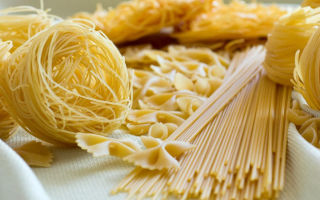Content
- 1 Pasta varieties and their features
- 2 Vitamins and minerals in pasta
- 3 Nutritional value and calorie content of pasta
- 4 Useful properties of pasta
- 5 Is it possible to eat pasta while losing weight
- 6 Is it possible to pasta for pregnant and lactating mothers
- 7 At what age can children be given pasta
- 8 The benefits and harms of colorful pasta
- 9 What are the benefits of spelled pasta
- 10 What time of day is it better to eat pasta
- 11 How to cook pasta correctly
- 12 What is pasta combined with
- 13 Harm of pasta and contraindications to use
- 14 Which is healthier: pasta or spaghetti
- 15 How to choose pasta
- 16 Conclusion
It is difficult to find a person who has never tasted pasta at least once in his life. The benefits and harms of pasta do not stop worrying consumers. Opinions differ: some call the product useful, others believe that people get fat from flour products. Who is right?
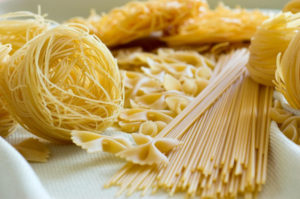
Pasta varieties and their features
Pasta can be different in appearance. But the main difference is the variety. For the production of the product, flour of different varieties is used, you can learn about this from the inscription on the package.
Pasta groups:
- Group A. Healthy pasta is obtained from durum wheat. Such a product not only has beneficial properties, but also has a special quality after cooking. They do not lose their shape, do not stick together even with the addition of a small amount of oil.
- Group B. For the manufacture of the product, 1 or premium glassy wheat flour is used.
- Group B. Despite the fact that regular flour intended for baking bread is not a perfectly suitable product for pasta, some manufacturers use it anyway. Pasta is of low quality; during cooking it loses its appearance and sticks together. The production cost is low.
Pastry products differ not only in group, but also in appearance and purpose. They are:
- long and short;
- large and small;
- curly;
- with different fillings;
- for baking.
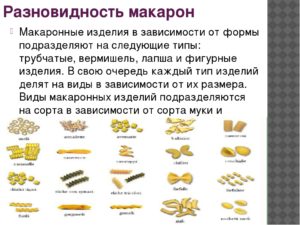
The taste and color of the product may be different, since they use flour from wheat, buckwheat, rice, corn, barley.
Vitamins and minerals in pasta
Boiled pasta contains vitamins A, PP, E, as well as 6 B vitamins.
Products are rich:
- sodium and potassium;
- magnesium and sulfur;
- phosphorus.
Having this amount of vitamins and minerals increases the health benefits of pasta and minimizes harm.
Nutritional value and calorie content of pasta
Before talking about the benefits or dangers of pasta, you need to know the nutritional value and calorie content of the product.
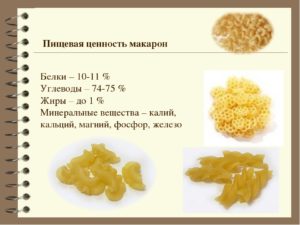
As a rule, these products are boiled. The nutritional value of a dry product is from 327 to 351 Kcal, after cooking - no more than 80 Kcal.
You can learn more about the benefits of pasta for the body from the video below:
Useful properties of pasta
To understand the benefits of durum wheat pasta, you need to understand their properties:
- All products contain fiber. Most of this substance is found in products made from durum wheat. Eating pasta helps to remove toxins from the body, helps cleanse the intestines.
- Thanks to the B vitamins, mood improves. Decreases headache with migraines.
- The content of a large amount of carbohydrates (about 70%) should not scare diabetics, since they are complex, their absorption is slow.Therefore, the blood sugar level does not rise.
- Carbohydrates contribute to quick satiety, so eating pasta at night is not recommended.
- Vitamin E is responsible for men's health, which means for the well-being of the family.
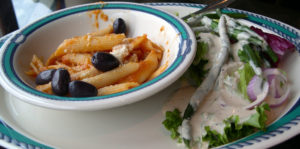
Is it possible to eat pasta while losing weight
For a long time, there was an opinion that pasta is harmful to the figure. In fact, the opposite is true. Nutritionists even create weight loss menus that include this product.
Getting better from whole grain pasta rich in nutrients, fiber and vitamins is almost impossible. After all, one serving of 100 g saturates for a long time. And in combination with vegetables, it fills the body with energy.
So, while on a diet, there is no need to put taboo on pasta. The main thing is to choose a useful and correct product.
Is it possible to pasta for pregnant and lactating mothers
Pregnant women and nursing mothers can safely include their favorite pasta in their diet. You just don't need to buy group B products made from baking flour. These pasta can harm both mother and baby.
At what age can children be given pasta
Since in Russian families boiled pasta or soups with them is one of their favorite dishes, they are also given to young children. This is not prohibited, you just need to know when the child's body will be able to digest the product.
Ordinary pasta can be given to babies from 12 months, although pediatricians advise including them from 1.5-2 years. At this age, children have enough teeth to chew.
A child needs pasta for:
- strengthening the immune system;
- hair and teeth growth;
- activation of blood renewal processes.

The benefits and harms of colorful pasta
On the shelves in stores are bags of pasta of different colors. Children like them very much. Parents are interested in whether such multi-colored flour products are useful or harmful.
If natural products are used to add color, and not dyes, then this is a useful product that can be included in the diet of children.
What gives color:
- orange pasta becomes from carrot juice;
- green - from spinach juice;
- black - from cuttlefish juice.

What are the benefits of spelled pasta
When the word "spelled" always comes to mind the tale of Alexander Pushkin. In fact, this is a special type of flour that surpasses all other types in fiber content. There is no harm from whole grain pasta, but the benefits can hardly be overestimated. Indeed, the products contain 18 amino acids necessary for the human body.
People who regularly consume spelled pasta and durum wheat are less likely to get sick:
- diabetes mellitus;
- obesity;
- anemia;
- viral and infectious diseases;
- oncology.
The risk of stroke and heart attack is also reduced due to the special properties of these products.

What time of day is it better to eat pasta
You can eat pasta at any time of the day. But if you do not want to get better from pasta, then it is best to cook dishes from them for breakfast, lunch or afternoon tea. In this case, carbohydrates will be burned and not deposited on the waist.
How to cook pasta correctly
In order for the finished dish to benefit and reveal its properties, it must be properly prepared.
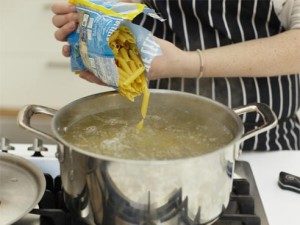
Cooking steps:
- For each kg of product, take at least 1 liter of water and a large saucepan.The fact is that pasta during cooking absorbs water and increases in volume.
- Wait for the water to boil, add salt to taste.
- After a minute, add pasta, use a spoon to distribute them in the liquid.
- Cook after boiling over low heat, without covering the pan with a lid.
- Many housewives put some vegetable oil into the water before filling pasta to prevent sticking.
- Cook for 7-15 minutes, depending on the type of product. Time is always written on the package. But it's best to taste boiled pasta.
- Put the contents of the pot in a colander to drain the water.
- Transfer the finished dish to a saucepan, add vegetable or butter.
The dish is eaten hot with any vegetable salads, cutlets, fish.
What is pasta combined with
Healthy pasta can be prepared with various additives, they are combined:
- with any vegetables: tomatoes, zucchini, squash, bell pepper, garlic, onions and green onions;
- with herbs: spinach, basil, dill;
- with meat and fish dishes;
- with different types of cheese;
- with seafood;
- with various sauces and spices.
With pasta available, you can prepare many tasty and healthy snacks, soups, salads.
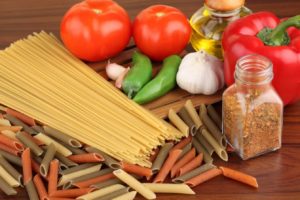
Harm of pasta and contraindications to use
Unfortunately, many consumers do not know that among the large assortment of pasta, there are many that can be harmful to health. This applies to the Chinese instant noodles, the so-called "Rolton", "Doshirak".
There is more harm than good in such vermicelli:
- First of all, the contents have already been heat-treated before packaging.
- Secondly, the product contains a large amount of preservatives that are harmful to health.
- Thirdly, instead of meat and fish products, noodles and vermicelli are saturated with taste imitators.
- Fourth, Instant noodles and noodles often contain harmful additives such as trans fats.
If we talk about contraindications, then this is either intolerance to the product, or a ban on consumption after bowel surgery.
Which is healthier: pasta or spaghetti
The right pasta, according to nutritionists, has beneficial properties. Of course, if you do not eat pasta at night in large portions. We are not talking about all types and varieties of this product, namely about spaghetti or, as the Italians say, pasta.
The benefits of spaghetti are that they are made from durum wheat:
- It is such a product that is recommended for lowering cholesterol levels, for problems with the cardiovascular system. In Italy, they believe that a serving of spaghetti is able to raise vitality, since they contain a large amount of amino acids. They activate the production of serotonin, which is called the hormone of happiness.
- The advantage of durum wheat spaghetti is also that they contain selenium, which does not allow the cells of the human body to degenerate.

How to choose pasta
When choosing pasta, you need to pay attention to the following points:
- The most useful products of group A and B are sold only in sealed packs.
- The composition should not contain eggs, but only water and flour of a certain type.
- Most of all useful properties are in products made from durum flour.
- The type and variety of flour is also important, because not everyone can tolerate wheat. Therefore, you need to pay attention to this too. Pasta is made from buckwheat, barley, corn and rice flour.
- Do not think that you should buy only those products that are made from premium and first grade flour.No less useful in 2 grade pasta, since coarse flour, containing a lot of fiber, is used for their manufacture.
Appearance of pasta
You need to pay attention to the appearance of the product. Good quality pasta should be golden or amber in color. If the products are pungent yellow, then synthetic dyes are added to them. If the product is white or grayish, then poor quality flour was used for the manufacture.
It is equally important to consider the structure of pasta:
- Dark blotches are one of the important characteristics of the product. They show that the pasta is made with whole grain.
- On the products there are white specks and a rough surface - low quality flour was used.
- If the shape of all pasta is the same, corresponds to the name, you can buy.
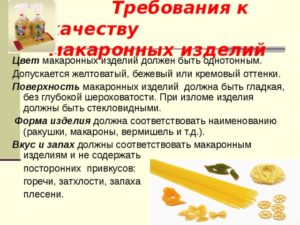
Checking the quality of pasta
It is impossible to make an accurate picture of the quality of pasta from the inscription on the label and the appearance. Further verification needs to be done at home:
- High quality products do not break but bend easily.
- If soft flour is used in the manufacture (which is unacceptable according to GOST), then there will be a lot of crumbs in the pack or bag.
- The next stage of verification is cooking. A high-quality and healthy product made from durum wheat will not stick together, will not lose shape.
- The water remains almost transparent during preparation, the turbidity is negligible.
- All that remains is to try the dish. If you feel bitterness, it means that the flour was stored incorrectly. Bitterness is the result of the spoiled fats found in wheat grains.
Conclusion
Fans of flour products should understand that the benefits and harms of pasta can go at the same time. It all depends on the quality of the product and the flour used for production.

